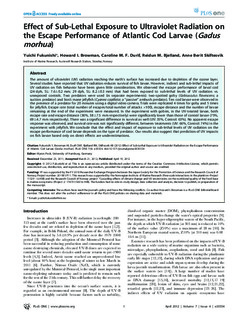| dc.description.abstract | The amount of ultraviolet (UV) radiation reaching the earth’s surface has increased due to depletion of the ozone layer.
Several studies have reported that UV radiation reduces survival of fish larvae. However, indirect and sub-lethal impacts of
UV radiation on fish behavior have been given little consideration. We observed the escape performance of larval cod
(24 dph, SL: 7.6+-0.2 mm; 29 dph, SL: 8.2+-0.3 mm) that had been exposed to sub-lethal levels of UV radiation vs.
unexposed controls. Two predators were used (in separate experiments): two-spotted goby (Gobiusculus flavescens; a
suction predator) and lion’s mane jellyfish (Cyanea capillata; a ‘‘passive’’ ambush predator). Ten cod larvae were observed in
the presence of a predator for 20 minutes using a digital video camera. Trials were replicated 4 times for goby and 5 times
for jellyfish. Escape rate (total number of escapes/total number of attacks x 100), escape distance and the number of larvae
remaining at the end of the experiment were measured. In the experiment with gobies, in the UV-treated larvae, both
escape rate and escape distance (36%, 38+-7.5 mm respectively) were significantly lower than those of control larvae (75%,
69+-4.7 mm respectively). There was a significant difference in survival as well (UV: 35%, Control: 63%). No apparent escape
response was observed, and survival rate was not significantly different, between treatments (UV: 66%, Control: 74%) in the
experiment with jellyfish. We conclude that the effect and impact of exposure to sub-lethal levels of UV radiation on the
escape performance of cod larvae depends on the type of predator. Our results also suggest that prediction of UV impacts
on fish larvae based only on direct effects are underestimations. | no_NO |
